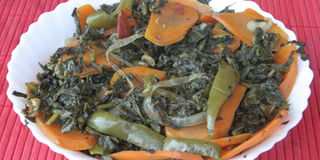Nakati: Salty and bitter greens with a unique taste

A plate of Nakati. Photo by Ismail Kezaala
What you need to know:
VEGETABLE FOR ALL SEASONS: It has established its place on the dining table as a sauce, vegetable and source of vitamins.
In one of Kampala’s restaurants, a story is told of a woman from Bundibugyo who caused a scene when she was served nakati. She screamed insults and curses at the waiter for serving her “salty and bitter grass” as if she is a goat. Her wild suspicion was not helped by the fact that this ‘salty and bitter grass’ was served alone moreover in small quantities. She wondered why it was not mixed with the main sauce of meat or eaten as a sauce on its own.
This, exactly, is what nakati, whose scientific name is Solanumaethiopicum, will come off as, to a first time eater. It will not taste as delicious as other greens like dodo or sukumawiki, for the first time, that is. Nakati, interestingly a name shared by Uganda’s diverse ethnic groups, has that distinctive taste (mistaken as bitter and salty) that makes it nakati and not dodo or nswiga for instance.
A wide range of research about nakati will reveal the green, is one of the most important vegetables in Sub Saharan Africa.It is however not traceable when and how it found its place in the Ugandan cuisine. What most are certain about though is that it has been around and its popularity is catching up with the other famous greens.
“Gone are the days when people thought greens were for the poor who could not afford meat. Of late, a good number of my customers are from well to do families and I know nakati sells in those restaurants,” observes Margaret Wanyana, a vendor of greens based in Kalerwe market for over 14 years. She notes that the trend of demand for nakati has tremendously changed over the years. “The big hotels still underlooklocal Ugandan greens in preference for exotic ones from the west.”
At Ekitobero Restaurant in Nakasero, which specialises in traditional dishes, nakati is a common item in many patrons’ plates.
“The beauty about nakati is that it can go along with meat, groundnut stew, beans and any other sauce,” shares Joel Kidandaire, a regular patron at the eat-out. According to him, the salty and bitter taste as some people call it makes the green stand out from others as the ultimate meal ender.
Marlyn Tibaijuka, a food vendor at Nakasero market, says some customers go ahead to ask for nakati as a sauce of its own, probably fried or mixed with groundnut stew like any other main course sauce. This to some, comes off as weird, especially given the fact that in almost all regions of the country, the conventional mode of preparation dictates that nakati be eaten and cooked as a side dish.
“I think cooking of any type of food must evolve with the changes and demand trends of society. If some people prefer nakati as a sauce and not side dish, why not?” she asserts.




